Google (NASDAQ:GOOGL) parent company Alphabet (NASDAQ:GOOG) is due to release results today after the closing bell. Estimates call for earnings per share of $8.04 and $37.7 billion in revenue, down from the same quarter last year, when it reported $14.21 in EPS on $38.94 billion in revenue.
The company’s revenues have been patchy, with two misses in the previous five quarters. Earnings have been worse, with three misses in the last five quarters. The tricky part of attempting to get a handle on a stock like Google is that it is dealing with contradictory market drivers.
Will Google’s stock price benefit from a "stay-at-home" world, in which most people spend most of their time working, shopping and getting their entertainment online? Or will Google’s main revenue stream—advertising dollars—dry out, as advertisers tighten their purse strings?
There are enough moving parts to give any poor analyst a headache.
Let’s see what the chart says.

Google was mired in indecision for two whole months between early May and early July. The bulls managed to push the stock out of the swamp after news that the company had joined the "$1 Trillion Club" when its market capitalization reached this threshold, showing resilience in the face of the pandemic. The stock’s IBD SmartSelect Composite Rating jumped to 97 from 93 a day earlier.
Price
Still, the stock has been ranging, having gained only 1.7% since July 6. Such congestions may be signs of a reversal. The current range that has been in place since July 6 may be topping out, and that would put a much larger H&S reversal pattern on target.
The MACD’s short MA fell below the long MA, as the price of the stock has weakened.
Volume
Volume has been subdued, below the 20 DMA. The only volume spikes within the formation of the larger pattern have been on down-days.
The volume oscillator has broken down and found resistance by the broken uptrend line.
Momentum
The RSI is moving in the opposite direction, as momentum falls while the price rises.
Note of Caution
To clarify, the trend is still up, both in terms of the peaks and troughs, as well as respecting the uptrend line. We do not know that the price will reverse course. We are simply pointing out that the trend is faltering. A reversal will require for the smaller, rather than the larger, pattern to reach completion.
Trading Strategies
Conservative traders would wait for the larger H&S top to complete.
Moderate traders might be content with a downside breakout of the smaller pattern, preferably to include the uptrend line.
Aggressive traders may risk a short now, providing they understand, and embrace, the risk of a trade that would be just a small part of their overall trading gamut and have the temperament to withstand this risk.
Trade Sample—Aggressive Short Position
- Entry: $1,575 – upon a rally
- Stop-Loss: $1,585
- Risk: $10
- Target: $1,475
- Reward: $100
- Risk-Reward Ratio: 1:10
Note: This is an aggressive trade, appropriate only for traders who understand portfolio allocation and risk management. If this isn’t you, don’t trade. Also, the components of the trade are not set in stone. Change them to fit your needs, and if you don’t know how to do this, don’t trade. If you didn’t understand the post, don’t trade.
